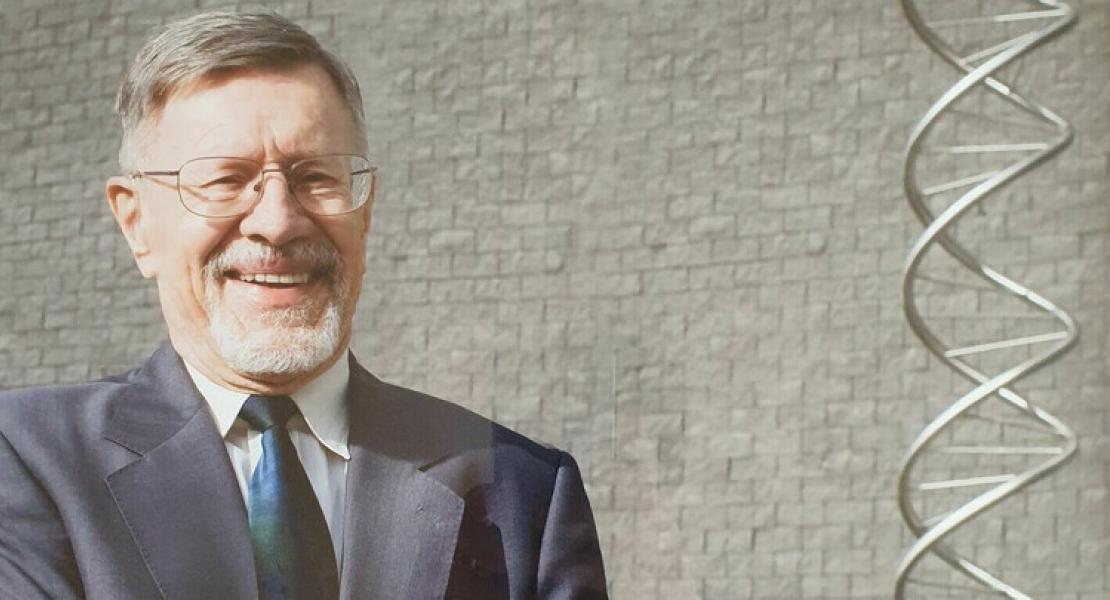Walter Fiers, one of the founders of VIB and an exceptional scientist, passed away on July 28th, 2019.
Walter Fiers was born on January 31st, 1931 in Ieper.
In 1954 he obtains his degree as chemical engineer at the Ghent University. Following this, he works for a few years in top laboratories in the United Stated with the support of the Rockefeller Foundation and the National Fund for Scientific Research (now FWO). In 1963, he receives his doctorate in chemistry from Ghent University, which marked the start of an academic career at his alma mater.
Even early in his scientific career, Walter Fiers provides breakthroughs. During his time in the United States, he begins to unravel the genome structure of the bacteriophage Phi X 174, a virus that infects E. coli, among others. He is the first person to show that it is a circular molecule, a groundbreaking conclusion at the time. The discovery was so unexpected that it was described in no less than three scientific articles sent in on the same day and accepted for publication in the Journal of Molecular Biology1.
But Walter Fiers was no ‘one hit wonder’. He and his team are the first to decipher the full sequence of a gene, followed swiftly by the complete sequencing of the viral genomes of MS2 and SV4; the first full genome sequence in the world! Even then, Flemish biotechnology was world class. This knowledge, and the procedures Walter and his team developed to gain it, are the foundation of our current capacity to clone and express any gene in bacteria.
After these world-firsts another string of breakthroughs followed, published in top journals Nature and Science, such as the clarification of the structure of the first oncogene, cloning and sequencing β-interferon, interferon γ, interleukin 2, and tumor necrosis factor (TNF).
Walter Fiers quickly recognized the power of his discoveries and dedicated himself to the influenza A or flu virus. Through deciphering the genome sequence of the virus, the knowledge concerning it grew rapidly. Now, Walter Fiers and colleagues could not only show how the flu could adapt to vaccines so quickly, but also how flu pandemics arise.
Since VIB’s beginning, Walter Fiers was heavily involved in the institute, both as founding father and top scientist. His groundbreaking work helps in attracting talented researchers and contributes substantially to VIB’s growth. Even following his retirement Walter Fiers remained active in world leading science. Together with Xavier Saelens, also a VIB-UGent group leader, he continued to work on their quest to develop a universal flu vaccine.
His work in the early days of genome sequencing is rightfully recognized as one of the major breakthroughs in biology and biotechnology, both in terms of fundamental knowledge and potential application. Walter Fiers received numerous prestigious international awards, such as the Francqui prize, the Carlos J. Finlay prize, the Baillet Latour prize and the Robert Koch prize. In 1990 Walter was awarded royal recognition and official named baron.
Jo Bury, managing director of VIB: “Walter Fiers was an excellent scientist with a spotless international reputation. He was multidisciplinary ‘avant la lettre’. He used his background in chemistry to develop novel technologies that allowed him to decipher the biology of organisms on a molecular level. A lot of his work can be found today in textbooks young researchers and student use to discover the discipline of molecular biology. Walter Fiers was an inspiring leader!”
---
1 Fiers W, Sinsheimer RL. 1962. The structure of the DNA of bacteriophage phi-X174. I. The action of exopolynucleotidases. Journal of Molecular Biology 5:408-419.
Fiers W, Sinsheimer RL. 1962. The structure of the DNA of bacteriophage phi-X174. II. Thermal inactivation. Journal of Molecular Biology 5:420-423.
Fiers W, Sinsheimer RL. 1962. The structure of the DNA of bacteriophage phi-X174. III. Ultracentrifugal evidence for a ring structure. Journal of Molecular Biology 5:424-434.
- Log in to post comments
